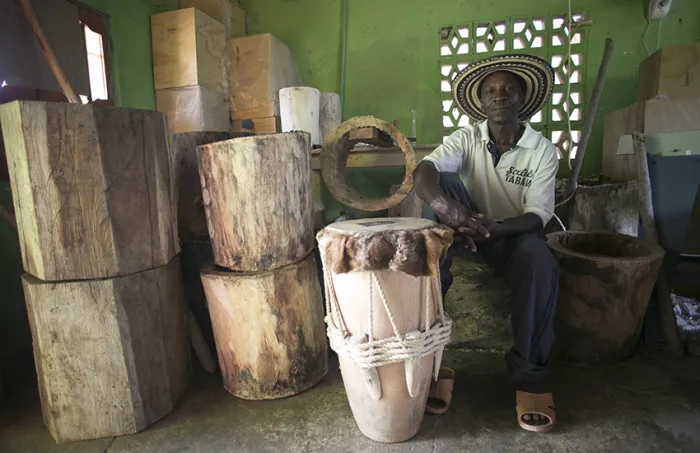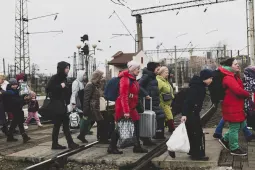Searching for Oscar Murillo in a Small Town in Colombia

PALENQUE — Artist Oscar Murillo is a paradox. He’s Black, famous, and Colombian. He grew up in a small town called La Paila, where his parents worked at Colombina, a well-known chocolate factory. When Murillo was 10, the family moved to London. This would later inspire the performance “The Cleaners Late Summer Nights Party” (2012), where the cleaning staff who worked alongside his parents threw a party at London’s Serpentine Gallery. It appears as though Murillo staged the performance in order to mock the ways in which class, economy, and power played out within the context of an art show. In 2015, he staged “A Mercantile Novel,” an installation of the Colombina factory at David Zwirner Gallery in New York. By enacting the lives of cleaners and factory workers at an art gallery, Murillo essentially waltzed in and unashamedly questioned who gets to go where and do what in the art world. Or at least, that’s how it seemed to me at the time. I found it quite remarkable and thought that perhaps one day, I could produce a sequel to Murillo’s installation as an independent curator in Brooklyn.
On the last day of August this year, I found myself sauntering through San Basilio de Palenque, the first free town of African slaves in the Americas, which dates back to the 17th century. I immediately thought of Murillo and Colombina. It made me wonder if this place might bear some resemblance to his La Palia, and if I could find inspiration for my sequel — some idea I could take back home to Brooklyn with me to share — right here.
The word palenque means “arena” or “ring.” Roughly 4,000 people live in this town which, cut off from Cartagena, lies along the Caribbean coast. After Brazil, Colombia boasts the second-highest number of people of African descent within South America: roughly 10 percent of the population. Palenque is pretty much sealed off from the rest of the country. It’s distinctly Black, unlike other Afro-Colombian communities, and quite proud of it.
When I first arrived, I felt as though I was on a day trip to a theme park in a fairytale African town. As someone who was born and raised in the Horn of Africa, this made me feel intensely awkward. Everything seemed so deliberate in Palenque, even though it looked basically like most small, obscure towns that money has left behind. I was terribly restless. Each empty street corner looked the same. I thought I had seen it all before: a small ghost town with potholed dusty roads, skinny stray dogs, and kooky 80-year-old women with thick silver cornrows, shiny golden sandals, and no teeth, scavenging for food.
But soon I began to see how far Palenque had been possessed by a real longing for Africa. Almost everything was as iconically Black and vaguely African. Palenquero, the local language which sounds like Lingala and Portuguese jumbled up with only a hint of Spanish, was scrawled across walls and murals everywhere. And all around me were relics of Black heroes, like a life-size statue of world-famous boxer Kid Pambelé, who was born in Palenque in 1945, looking invincible, punching his fists up in midair. Scores of elders, disheveled and a lot older than Pambelé, trickled into the local cultural center for a routine meeting late one morning. They looked as though they were holding Palenque’s last breath in their feeble hearts. La Reina de Kongo, the only local hair salon, where you could get long, shiny braids in under an hour, looked oddly familiar and I realized it resembled a quaint shack on a street corner in Kinshasa. This lingering longing for Africa, particularly the Congo, so far away and nebulous, became quite poignant.
I realized that it wasn’t so much what I saw that bothered me, but the way I was looking at things. I was staring at everything and everyone, so eager to find the sequel to Murillo’s Colombia through my first impressions of Palenque. Meanwhile, everyone performed nostalgia well, and I watched them gleefully, as though all of Palenque were a dark, lonely stage. My gaze was pure voyeurism. I had become a cliché, defining a community I barely understood along the tenuous lines of race, class, and consumption. I had allowed myself to be mesmerized by all the nostalgia, which probably explains why I saw nothing at first. Even if Murillo poked fun at the art world’s oblivion, its privilege, the gilded cage in which everything, including the lives of factory workers and cleaners, could be reenacted as a work of art, what a fool I was to think that my stint in Palenque would instantly morph into a Murillo sequel. My ridiculous gaze might as well have been a sequel in and of itself. I realized that, apart from the fact that we were all, in some shape or form, of African descent (which could mean so many different things), Murillo, Palenque, and myself had very little in common.
How could a naïve art critic like myself misconstrue this iconic place? How could I have not noticed that all these displays of Palenque’s resilience, its courage and heroism, were also mired in social and economic misery? The village still has no paved roads, no running water. It’s a semi-autonomous commune inhabited by the descendants of freed slaves from the Congo, with a locally run school and an unarmed police force. Palenque seems to have been largely forgotten by the Colombian government. Some officials from my fellowship program seemed appalled that so little has changed over the years, despite the town having been named a UNESCO World Heritage Site in 2005. What struck them was, even after all these years, how deprived Palenque looks.
That afternoon, we watched Rafael Cassiani Cassiani, who leads the Sexteto Tabalá band. He sang beautifully, and he left us with a sobering thought: “Esta tierra no es mía, esta tierra no mía, esta tierra es de la nacíon”: “The land isn’t mine, this land isn’t mine, this land belongs to the state.” Sadly, this lone Black village could soon be swept away by the conflict that continues to afflict some parts of rural Colombia, especially after the failed peace deal between the government and the FARC (Revolutionary Armed Forces of Colombia) in October.
On the other hand, Murillo has done something quite radical with his own personal story: He has helped us to understand that even if we’re not always welcome, we can still occupy museums and galleries, cracking open closed doors and windows with our bare fists and some degree of irony. More importantly, he is also helping us to imagine that perhaps one day, someone from La Paila or Palenque could use art to display a fragment of their story in a public space, to be experienced by people in Bogotá or New York or Kinshasa. That would, in my opinion, make their story that much more authentic and powerful.
That day, I felt that Palenque had morphed into nothing more than pure longing. But Perfecto Cassiani, the director of the Casa de la Cultura, thinks otherwise: “Palenque doesn’t only belong to the Palenque, it belongs to the whole world,” he said to me, gently, in an interview. That could take quite some time, since people aren’t exactly flocking in to see this unique village. Meanwhile, these Black heroes still have no real place to call home; in my eyes, they remain stuck, inward and melancholy, searching for a phantom Africa or a place called Congo. In Palenque, even joy seems retrospective, shrouded in the womb of a heroic past. Seeing the story of Palenque unfurl before the eyes of the art world would certainly be remarkable — but much more so if it were told by someone who was born and raised there, not by me and my misconstrued Oscar Murillo sequel.
This article, which was first published in Hyperallergic in November 2016, was made possible by the Gabriel Garcia Marquez fellowship in new journalism, which was held in Cartagena de Indias from August 29 to September 3.






